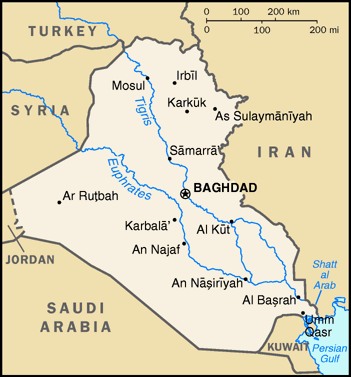In 2003, the US invaded and occupied Iraq for nearly a decade. During that occupation, the demographics of much of the country were dramatically redrawn, as areas with mixed Sunni and Shi’ite populations were quickly cleansed of one or the other, as the war took on an increasingly secular tone.
 That redrawing of Iraq split the country even more dramatically into Sunni and Shi’ite spheres, making way for ISIS to set up shop. The US attacked again in 2014, and is already dramatically redrawing the map once again, with the emphasis on air war meaning more wholesale destruction.
That redrawing of Iraq split the country even more dramatically into Sunni and Shi’ite spheres, making way for ISIS to set up shop. The US attacked again in 2014, and is already dramatically redrawing the map once again, with the emphasis on air war meaning more wholesale destruction.
Nowhere is that more clear than in Ramadi, the “capital” of Anbar Province, which was “liberated” in December and January, and also almost entirely destroyed. Iraqi officials have talked of massive damage in the city, and over half a year later civilians still aren’t being allowed back in in large numbers. A former city of over half a million people, it’s unclear if Ramadi will survive at all, but it clearly will never be the same.
Everywhere “liberation” has come, US airstrikes have followed, with widespread destruction across several towns on the frontier between ISIS and Iraqi government territory, and Iraqi officials looking toward a protracted battle in Mosul. It’s Iraq’s second largest city, or ISIS’ largest, depending on how you reckon it. Either way, the battle is going to involve heavy US airstrikes, and how much of Mosul will be left remains to be seen.





When this all comes home – and rest assured it eventually will – the Americans, especially those who have not been paying attention are going to wonder how this could possibly happen to us. And I believe the rest of the world is not going to be as supportive as they were after 9/11.
I think you’re right but now it’s confusing as to where it will come home from? When Trump goes down in flames it’s going to negate the chance of war with Russia, simply because MAD will continue to save the world. No sane politician will take that step. The psychopath would have had he been challenged.
I think you war wiser to allude to a hit from terrorists that is going to make 911 look like a $10 fireworks display.
But yes, the world will have sympathy again. And disdain of no particular country upon which the US will be able to take revenge. You see, there is no downside for the terrorist, freedom fighters, whatever they will be called.